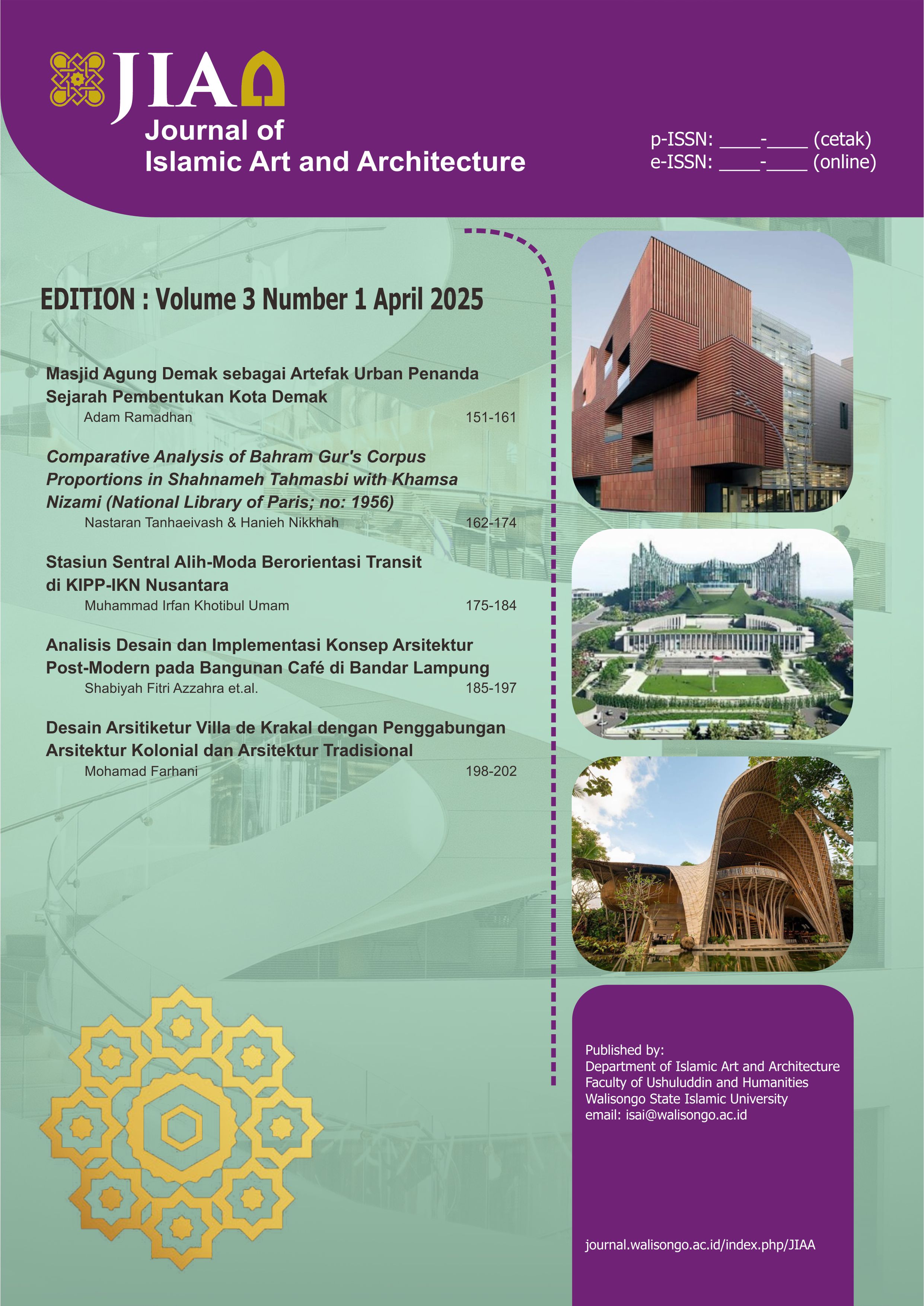Comparative Analysis of Bahram Gur's Corpus Proportions in Shahnameh Tahmasbi with Khamsa Nizami (National Library of Paris; No: 1956)
Abstract
During the Safavid era, the painting tradition involved proportional systems such as the golden ratio and irrational numbers. This article explores the use of irrational numbers to analyse the body proportions of Bahram Gur, a key figure in the painting. We also examine the coordination of geometric motifs in the Shahnameh Tahmasabi and Khamsa Nizami manuscripts to understand how these systems were employed in creating human figures. Our research aims to reconstruct the principles behind the harmonious proportions of Bahram Gur’s figure in these paintings. By conducting investigations and calculations, we found that the proportions of Bahram Gur’s body in both manuscripts frequently exhibited irrational numbers, without being tied to a specific image or theme
Keywords: figure proportion, bahram gur, shahnameh tahmasabi, khamsa nizami, golden proportions
Downloads
References
Afhemi, Reza; Tavousi, Mahmoud; Ayatollahi, Habibullah; Hejiri Nobri, Alireza, "Human proportion in Achaemenid art, a case study: the reliefs of the stairs of the Apadana Hall, Persepolis", Fine Arts Chapter, Vol. 28, 104-93, 2007.
Agenda, Yaqub. Painting School of Tabriz and Qazvin-Mashhad. Tehran: Farhangistan Art Academy, 2015.
Barry, Michael. "Michael Barry's commentary on Haft Paykar Nizami .translated by Jalal Alavinia", Tehran: Ney. 2006.
Canby, Sheila R. Iranian painting. translated by Mehdi Hosseini, Tehran: Art University, 2012.
Canby, Sheila R. The shahnama of shah tahmasp the Persian Book of Kings, NewYork Metropolitan Museum of Art. Metropolitan Museum of Art (New York, N.Y.), 287 p, 2011.
Fletcher, Robert,"Human Proportion: Human Proportion in Art and Anthropometry". A Lecture Delivered at the National Museum, Washington, D. C, M. R. C. S. b. Cambridge, King, 37 p. Ilustre. 8, /science. ns-2.32.354.a, . 1883.
Graber, Oleg. An overview of Iranian painting, translated by Mehrdad Vahdati Daneshmand, Tehran: Farhangistan Honar Publications, 2011.
Henry, Richard, A Review of “Islamic geometric design”, by Eric Broug. Journal of Mathematics and the Arts, 9:1-2, 48-53, 2015.
Masoumipour, Fariba; Farzaneh Farrokhfar,"Deconstruction in the human proportions of Shahnameh Tahmasabi's characters", Paj, vol. 36, pp. 162-146, . 2019.
Mirzaei, Mehr Ali Asghar.Criticism of Ganjai Military Khumseh paintings: Qasim Ali Sultan, (dated 968 A.H.). Tehran; Written heritage, 2020.
Nazarli, Mais, "The Two Worlds of Middle Eastern Book Illuminations. translated by Abbas Ali Ezzati, Tehran: Farhangistan Art Academy Publications", 2011.
Nicholson, Paul J. 2019. Leonardo da Vinci, The Proportions of the Human Figure (after Vitruvius). c, Oxford University Press on behalf of the Society of Occupational Medicine, Art and Occupation.86-88, 1490.
Papadopoulo, Alexandre. Islam and Muslim Art, T: Robert Erich Wolf, New York, Harry N. Adams, 1979.
Pirnia, Hassan; Iqbal Ashtiani, Abbas; Behnam Far, Mohammad Hassan. Complete History of Iran. Tehran: Arayan, 2015.
Rahimova, Zohra, A. Polyakova, Elena Artemovna. Iranian painting and literature. translated by Zohra Faizi, Tehran: Rozeneh, 1939.
Shah Kolahi, Fatemeh," a review of human figures in the works of Junaid al-Sultani based on the illustrated version of the three Masnavis of Khajawi Kermani (stored in the British Museum, No. 18113)" Nagareh Chapter, Vol. 46, 41-29, . 2018.
Downloads
Published
Issue
Section
License

This work is licensed under a Creative Commons Attribution-ShareAlike 4.0 International License.
Copyright
The copyright of the received article shall be assigned to the journal as the publisher of the journal. The intended copyright includes the right to publish the article in various forms (including reprints). The journal maintains the publishing rights to the published articles. Therefore, the author must submit a statement of the Copyright Transfer Agreement.*)
Licensing

This work is licensed under a Creative Commons Attribution-ShareAlike 4.0 International License.
In line with the license, authors are allowed to share and adapt the material. In addition, the material must be given appropriate credit, provided with a link to the license, and indicated if changes were made. If authors remix, transform or build upon the material, authors must distribute their contributions under the same license as the original.
_______
*) Authors whose articles are accepted for publication will receive confirmation via email and send a Copyright Transfer Agreement.






